With it's colorful flowers and fruit trees MONTE PLACIDO attracts interesting birds. We had a couple of guests that were professional bird watchers. Even though they were on vacation and only birding for fun, they were delighted to see 37 species during their one week stay, at least seven endemic to the Dominican Republic. Most of them were spotted right here on Monte Placido!
Monte Placido is centrally located to all the bird watching hot spots on the Samana Peninsula. While out on excursions to the Falls in El Limon, Los Haitises National Park, the whale watching on Samana Bay, or simply relaxing on the beach, keep your eyes open for interesting birds. We can arrange for a local amateur Dominican guide to take you on a hiking tour by foot or on horse, up in the mountains or into the lowlands and mangroves.
If you are a serious bird watcher we can recommend a professional guide. Kate Wallace lives in Santo Domingo and operates Tody Tours. It is interesting to note that Hispaniola is home to about 290 species of birds, and 31 endemic to the Dominican Republic. Three birds are now extinct in Haiti and found only in the Dominican Republic: Ridgeway Hawk, Bay-breasted Cuckoo and Eastern Chat-Tanager. The Ridgeway Hawk can be seen in Los Haitises National Park with a professional guide. We can organize the logistics for you to spend 1 night there.
Our list of birds includes birds that have been seen in a 10KM radius of Monte Placido by ourselves or our guests. We also included a few target species for Samana, like the Ashy-faced Owl. We hope to see the owl soon as we hear they are spotted nearby in El Portillo. Much of the information about the birds is summarized from the book by Steven Latta: Birds of the Dominican Republic and Haiti. We have also provided the local names of the birds. Most of the pictures are from images found on the internet. If possible, photos taken on Monte Placido are included.
Monte Placido is centrally located to all the bird watching hot spots on the Samana Peninsula. While out on excursions to the Falls in El Limon, Los Haitises National Park, the whale watching on Samana Bay, or simply relaxing on the beach, keep your eyes open for interesting birds. We can arrange for a local amateur Dominican guide to take you on a hiking tour by foot or on horse, up in the mountains or into the lowlands and mangroves.
If you are a serious bird watcher we can recommend a professional guide. Kate Wallace lives in Santo Domingo and operates Tody Tours. It is interesting to note that Hispaniola is home to about 290 species of birds, and 31 endemic to the Dominican Republic. Three birds are now extinct in Haiti and found only in the Dominican Republic: Ridgeway Hawk, Bay-breasted Cuckoo and Eastern Chat-Tanager. The Ridgeway Hawk can be seen in Los Haitises National Park with a professional guide. We can organize the logistics for you to spend 1 night there.
Our list of birds includes birds that have been seen in a 10KM radius of Monte Placido by ourselves or our guests. We also included a few target species for Samana, like the Ashy-faced Owl. We hope to see the owl soon as we hear they are spotted nearby in El Portillo. Much of the information about the birds is summarized from the book by Steven Latta: Birds of the Dominican Republic and Haiti. We have also provided the local names of the birds. Most of the pictures are from images found on the internet. If possible, photos taken on Monte Placido are included.
ENDEMIC BIRDS
Species and Subspecies unique to the Dominican Republic.
Species and Subspecies unique to the Dominican Republic.

Palm Chat, CIGUA PALMERA is the National Bird of the Dominican Republic. It is the sole member of its genus and family making it unique. You will see many Palm Chats on Monte Placido flying from palm tree top to palm tree top. It is a noisy bird with an array of strange, slurring, whistled call notes. Large nests are built in the top of Royal Palm Trees and are used communally by many pairs. Each nest chamber has a separate entrance. The nest can measure more than 1m in diameter. The picture of the Palm Chat and nest was taken off of the back terrace of the main house on Monte Placido.

Ashy-faced Owl, LECHUZA CARA CENIZA. A reddish brown, long legged owl with a silver grey, heart shaped face. Its voice is a series of high pitched ratchety clicks, sometimes followed by a hissing cry. It is found in the open woodlands and, moist and dry broadleaf forests. You may see one along the mountain hike as they are common to the Samana province, especially Los Haitises . The owl frequently roosts in palm tress and feeds on mice attracted by the palm fruit. They also eat bats, lizards, frogs and birds

.
Hispaniolan Woodpecker, CARPINTERO is a common bird on Monte Placido usually seen flocking in trees early morning and late afternoon. It has a loud rolling call interrupted by throaty noises. The Carpintero eats insects, fruits and seeds taken through probing and pecking on trees, bushes and cacti. It is considered a pest in some agricultural areas.
The Carpintero typically makes it's home inside the hollow on of a Royal Palm Tree.
The Carpintero typically makes it's home inside the hollow on of a Royal Palm Tree.
Hispaniolan Oriole, CIGUA CANARIA is a showy Oriole with it's distinctive yellow shoulders, rump and under tail coverlets. It is a common bird island wide. A young bird is in a avocado tree in the back of Monte Placido. In the immature bird the underparts are a dull olive yellow.

Hispaniolan Lizard Cuckoo, PAJARO BOBO is a large cuckoo and very cool looking bird. It is often seen moving through vegetation where it peruses lizards and large insects. On Monte Placido a pair was nesting in the Ficus Tree by the front gate. The nest was situated at a moderate height and was a well hidden rough structure of twigs.
White Necked Crow, CUERVO is a big, entirely black bird with a large bill and a red orange eye. They are heard and seen flying over Monte Placido on their way to lowland swamps, coastal mangroves, and broadleaf forests. The Cuervo has a loud voice and a distinctive laugh like call and squawk. One guest got a real close look at the Cuervo as it was perched in their backyard. They even noticed the red eye and thought it looked more like a raven than a crow.

Hispaniolan Parakeet, PERICO is large, bright green parakeet with a pointed tail. It has only been seen on Monte Placido in small flocks flying by. The Perico will feed on corn and other corps for which it is hunted and killed by farmers. It is also captured for the pet trade. A local in our village caught one and taught it to speak. Due to hunting, capture and loss of habitat, there has been a serious decline in the Perico population and the species is considered threatened

Broad Billed Tody, BARRANCOLI is a small, short tailed chunky bird with bright colors and a long flattened bill. This pretty little bird digs into the dirt and constructs a nest chamber at the end of a tunnel. We spotted some along the path of our mountain hike and even saw a nest hole in an earthen embankment.
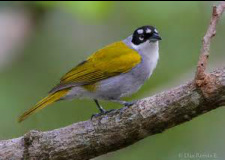
Black-crowned Palm-tanager, CUATRO OJOS. This robust bird has a black crown and facial mask. The mask has three white spots around the eye which gives the impression of four eyes and hence its Dominican name. The bird feeds on seeds and fruits and insects. It is usually found in heavy cover moving about in a slow deliberate fashion probing into crevices and holes. It also hops along branches or hangs on the bark of tree trunks. Cuatro Ojos is very widespread and common island wide. You may see one along the mountain hike.
RESIDENT BIRDS

Vervain Hummingbird, ZUMBADORCITO. For about 150 years this tiny beauty held the title of the worlds smallest bird. It was replaced by the Bee Hummingbird discovered in Cuba. Never the less, the Zumbadorcito on Monte Placido can fool you. Upon first look, you may think it is a large bumble bee. It can be spotted early in the morning buzzing around the flowers. You may hear it chirping like a cricket or making a loud prolonged twittering. The nest may be found in a bush, attached to the side of a branch. It looks like a deep cup made of plant fibers and covered with lichen, bark and cobwebs.

Antillean Mango Hummingbird, ZUMBADOR GRANDE. This is a large hummingbird with a slightly curved bill. The Zumbador Grande is commonly seen on Monte Placido flitting around the flowers. It's voice is rather loud and unmusical with a thin trill and also a sharp chirping.
The nest of the Zumbador Grande is in the same form as the Zumbadorcito.

Stolid Flycatcher, MANUELITO is a medium sized, large headed flycatcher with two pale white wing bars. It is an active bird that feeds on insects on the wing. Also feeds on fruits plucked while hovering. Several have been seen on Monte Placido although they favor the broad leaf forest on the mountain hike.

American Kestrel, CUYAYA. A small Falcon that hunts either from a perch or from hovering in the air. It feeds on small anthropoids and various small vertebrates. A pair was observed on Monte Placido nesting in the cavity of a palm tree on the side of the road going up the hill. It may also nest in the crevice of a cliff or an abandoned stick nest.

Greater Antillean Grackle, CHINCHILIN. A fairly large black bird with dark plumage, a long tail, a long conical, and a sharply pointed bill. They are a resident island wide. A few have been seen in and around Monte Placido. Typically they flock and often forage around livestock, feeding on insects. Nests are built in a tree scrub or vine.
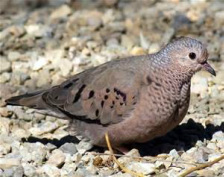
Common Ground Dove, ROLITA. Tiny, stocky Dove. By far the smallest on Hispaniola. It is found in the lowlands, especially in pastures, fields and clearings. Our guests saw one along the mountain hike. It feeds on tiny seeds of grasses and weeds. The nest is of rootlets, grasses and twigs and is built in a bush, tree or cactus. The voice of a dove is a soft "coo,coo,coo" or "hoop,hoop,hoop" and from Monte Placido a variety of doves can be heard in the distance.
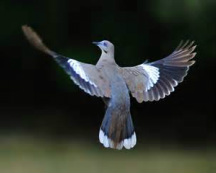
White Winged Dove, TO'RTOLA ALIBLANCA is a mid sized, heavy bodied grayish brown dove. It is spotted in flight on Monte Placido and readily distinguished by the large white central wing patch and white on the tip of the tail feathers. Its voice is a rhythmic "coo -coo- coo" that kind of sounds like "who cooks for you". The white Winged Dove is seen island wide and often feeding with the Common Ground Dove.

Mourning Dove, RABICHE. A mid sized slender dove with a small head and a long tapered tail with a with tip. It is the most common dove locally and also eats and feeds with the Common Ground Dove. It is often seen in the morning on the dirt road as you approach Monte Placido.

Red-tailed Hawk, GUARAGUAO is seen in flight on Monte Placido and easily recognized by it's red tail and sharp raspy scream. It is found in all habits in the Dominican Republic. The Guaraguao feeds on snakes, rodents, large invertebrates and other small birds. Guests spotted in flight a Petigre chasing a Red-tailed Hawk, as if the bird was chasing the hawk away from its nest.
Grey Kingbird, PETIGRE is a large bird with a distinct blackish mask often seen perched on telephone lines. Two of the pictures were taken of the Perigre perched on the railing of the terrace on Villa Jasmine, Monte Placido. He was chattering is his loud voice that sounds like "pe-ti-gre". It is an aggressive bird and sometimes attacks much larger species such as hawks and even dogs and cats.
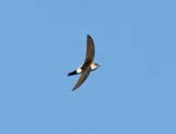
Antillean Palm Swift, VENCEJITO is the very small bird you see zooming around in flocks on Monte Placido, as they forage for insects on the wing. They have a rapid and erratic bat like flight, gliding between flapping spurts. They constantly emit a faint high pitched twitter. The Vencejito has a globular nest of plant fibers and other material glued with salvia to a frond of a Royal Palm. The nests have also been seen between the large Voyager Palm leaves near the pool.

Turkey Vulture, AURA TINOSA is the most visible bird in the afternoon on Monte Placido. It is a red headed vulture with extremely long wings, which it holds in a shallow "V" shape. They fly close to the ground and then soar in the air in tight circles, traveling on rising columns of air as they look for food. The Turkey Vulture has a sensitive sense of smell and appears to find most of its food from odor rather than visually. Its voice is usually silent.
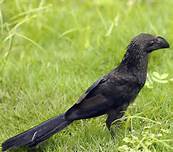
Smooth-billed Ani, JUDIO. A large, entirely black bird with a heavy parrot like bill and a long flat tail. It has been spotted around Monte Placido in the valley pasturelands. They are found in a wide range of open habitats with scattered trees and bushes. The nest is bulky and commonly used by several females.

Hispaniolan Pewee, MAROITA is a small flycatcher which occupies a variety of habitats in the Dominican Republic. Guests discovered this little delight in the scrubby woodlands while on the mountain hike near Monte Placido. It flies from a low perch to catch insects on the wing. It can also feed on small fruits.

Black-whiskered Vireo, JULIA'N CHIVI. A large Vireo, olive brown on top and whitish underneath. It has a repetitive and monotonous song that sounds like "julia'n chi - vi". Normally stays motionless in the dense canopy where it remains unnoticed except when singing. Feeds on insect it gleams from leaves. From August to February many migrate to South America.

Red-legged Thrush, CHUA'-CHUA'. A large Thrush distinguished by its reddish legs and bill, red eye ring, and white underparts and tail tips. Often seen at dawn as it darts from roadsides or forest openings. Forages mainly on the ground in leaf litter for invertebrates. Also eats fruits and lizards. Guests got a good look at one on the mountain hike.

White Crowned Pigeon, CASQUITO BLANCO. Medium sized pigeon that appears entirely slate gray except for its distinctive white crown. It nests in the costal mangroves and flies into adjacent broadleaf forests during the day to feed on fruit. The voice is a high pitched "cru, cru, cruuu" that kind of sounds like "who took two". One was heard and seen during the mountain hike.

Cattle Egret, GRAZA GANADERA is an insect specialist. It feeds on grasshoppers and other small insects kicked up by cows and horses. Sometimes it walks around Monte Placido and seems to tease our large dog, Bingo. We call it, "Bingo's bird". The Cattle Egret nests in colonies in trees and shrubs. From our hill you see flocks flying home over the wetlands below at sunset.

Rock Pigeon, PALOMA DOMESTICA is a medium sized, stocky, short necked pigeon with variable plumage. Its voice is a low gentle cooing. It is seen in the town of Las Terrenas nesting on the ledge of buildings, bridge or cliff.

House Sparrow, GORRI'ON CACERO is a stocky sparrow with shorter legs and a thick bill. Its call notes include a loud chirp or cheep. It is a permanent resident spreading nationwide especially near towns. The sparrow can be seen in the restaurants in Las Terrenas as it forages on the ground for food. Their nest sites are typically in nooks inside or on buildings.

Green Heron, CRA'-CRA'. Can be observed in the wetland thickets. Guests saw one near a pond on the mountain hike. It is a shy bird. Careful observers can see it stalking slowly through the water, or perched quietly atop a branch. It often produces a scolding squak or a piercing "skeow".

Common Moorhen, GALLARETA PICO ROJO is common in lowland, fresh water marshes. It is often seen in coastal lagoons bordered by mangroves. Gallareta Pico Rojo swims while foraging for aquatic plants, mollusks, worms and fruit. She stays close to the cover of vegetation and hides readily if disturbed..
Magnificent Frigatebird, TIJERETA. Most likely frigatebird one can observe along the costal waters. They are very adept at fishing, using a surface dip. They have been seen along the local beaches and even flying over Monte Placido.

Brown Pelican, PELICANO. A large brown costal seabird with an unmistakable bill. Is voice is usually silent. It is a common year round resident along nearly the entire coast. The Brown Pelican makes spectacular aerial dives for fish, its entire body sometimes disappearing beneath the surface. Fish are snared in its immense bill, the water drained, and the fish then swallowed whole. Seen by guests at Playa Rincon and in the Samana Bay area.

Snowy Egret, GARZA DE RIZOS. A medium sized, slender, entirely white heron. Found in the lowlands, and frequents coastal and interior wetlands of all types. It has black legs, yellow feet and lores, and a thin, pure black bill. It is very active while foraging, running and jumping to seize prey.

Tricolored Heron, GARZA PECHIBLANCO. An active heron with a very long bill and neck. Distinguished by its blue grey head, neck, and upperparts, mixed with brown. They contrast with a while belly, under tail coverts and underwing coverts. Is found in the lowlands and most frequently near the coast in mangrove swamps, lagoons and mouths of rivers.

Little Blue Heron, GARZA AZUL. A medium sized heron with unique plumage. Like the Reddish Egret the bird has two color phases. The adult bird is dark salty blue grey and the immature bird is all white. The white immature strongly resembles the Snowy Egret but the base of the bill is pale grey, it lacks yellow on its lores, and the legs are greenish. Unlike the active Snowy Egret, it is a very inactive feeder and moves slowly or stands motionless. Occurs at lakes, rivers, marshes and coastal lagoons island wide.
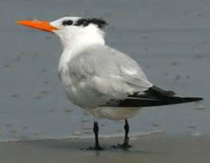
Royal Tern, CHARRA'N REAL. A large tern, pale grey above, white below, with a bright orange-red bill, and a cap across the top and back of the head. Occurs in coastal lagoon, beaches and harbors. Also can be found inland at both fresh and salt water lakes in the lowlands. It is a breeding resident, but seem most often from September to April as numbers increase when they are joined by non-breading visitors.
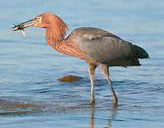
Reddish Egret, GARZA ROJIZA. The long heavy bill is pinkish with a black tip. This heron has two color phases. The adult dark form is slat grey overall with the head and neck a reddish brown. The immature white phase birds are entirely white. The distinctive foraging behavior is energetic as it dashes in pursuit of prey, often with wings spread in a canopy. It is a resident of coastal lagoons, brackish ponds, salt ponds and bays nationwide. It is listed as a target species for the Samana Bay area.
MIGRANT BIRDS

Osprey, GUINCHO. Is a unique raptor that dives from the air to capture fish near the waters surface. They then use their reversible outer toe to aide in gripping the fish during flight back to a feeding perch. They can be observed along the beaches with a large stick nest placed high in a tall tree or sometimes on artificial structures like power poles. Its voice is a series of short piercing whistles.

Spotted Sandpiper, PLAYERITO MANCHADO. It is known as the little shore bird, teetering along the waters edge. The characteristic teetering behavior has led to nick names of teeter peep, teeter bob, and tip tail. Its voice is a high whistled "weet - weet". Is feeds on a variety of animal matter in costal lowlands, edges of ponds, lakes and rivers. Guest saw "tip tail" on Las Terrenas beach beside a small creek.

Caribbean Martin, GOLONDRINA GARANDE. A large bicolored swallow with a forked tail. Upperparts head and throat are a metallic blue. The belly is white. There is a dark band across the vent. It has a rich liquid gurgling voice which includes a high "twick-twick". It is seen wherever nesting suitable dead tress with old woodpecker holes are found, along coastlines, in towns, open country and mountains. Is on island late January to late September.
WARBLERS

Ovenbird, PATICO. A large ground dwelling warbler. Upperparts greyish olive, with an orange crown bordered by blackish stripes and a bold white eye ring. Its voice is a fairly loud "chup" or "check" and its song sounds like an explosive "teacher - teacher - teacher". It is found mostly at middle elevations and favors coffee plantations. Ovenbirds glean prey from leaf litter, primarily taking ants, beetles and seeds, also snails and spiders. Seen in a mixed flock on the mountain hike.
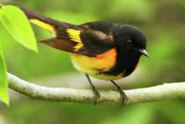
American Redstart, BIJIRITA CANDELITA. A small, active warbler. Adult male has black upperparts, throat and breast, and large yellow or orange patches on wings, tail and sides. It is abundant in broad leaf forests and was seen in a mixed flock on the mountain hike. Arrives in late September and heads north in March. Behavior includes acrobatic flycatching with birds appearing to fall through vegetation with flapping and flashing of yellow/orange wing and tail markings. Hence the name "candelita" (little candle).

Northern Parula, CIGUITA PARULA. A small warbler. Upperparts are blue grey and washed green, with a distinct green yellow patch on the mantle. Call note "tischp". Usually arrives in September and departs early April. Seen in a mixed flock on the mountain hike.

Black-throated Blue Warbler, CIGUITA AZUL. Medium sized fairly stocky warbler. The male is dark blue and the female a drab grey. It has a small but distinct white patch on the wing. The voice is a fairly sharp "tisk" or "tuck", like two coins being struck together. Arrives in late September and leaves in late April. Forages in low vegetation for insects and spiders. Also takes small fruit and nectar when available. Seen in a mixed flock on the mountain hike.















